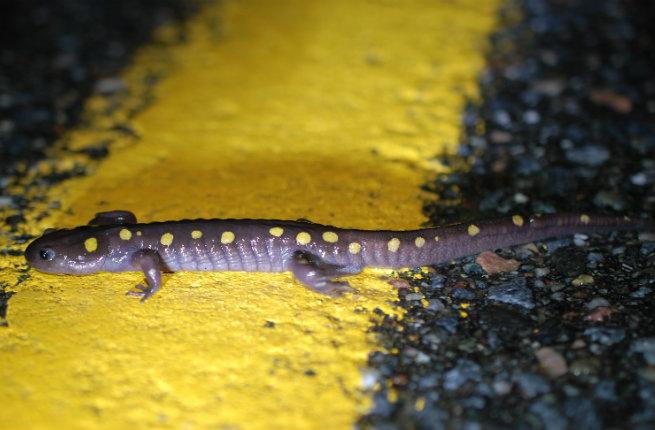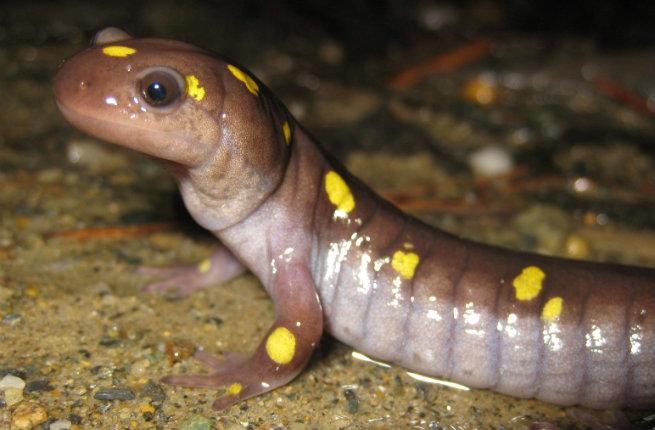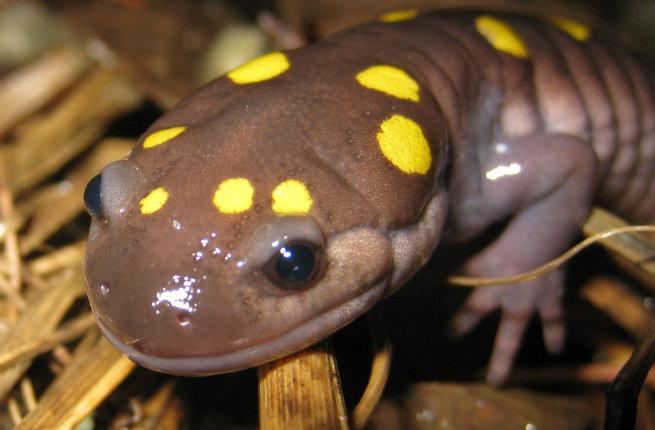
When spring days begin to thaw Vermont’s frozen ground, countless tiny amphibians stir after a long winter sleep. And on the first warm, wet nights of the year, spotted salamanders poke their rounded snouts out of their burrows, then start an annual trip to the ponds where they mate.
It’s a crawl that takes salamanders and other amphibians through the forest—and often across busy roads. “On a ‘Big Night’ when lots of amphibians are moving, you’ll see hundreds and hundreds,” says Larry Clarfeld, who helped develop an amphibian monitoring program at Vermont’s North Branch Nature Center. “But from a car, a spotted salamander just looks like a stick.”
So Vermont’s nature lovers have formed teams of volunteers to help the amphibians make the trip across the “squish zone” in safety. Networks of websites broadcast migration forecasts, create training videos, and encourage locals to add their nearest road crossing to a growing Amphibian and Reptile Atlas. And when the conditions are right, the volunteer crossing guards don raincoats and reflective vests, then head into the dark to scoop up salamanders in their bare hands for the trip across the road.
Salamanders are often dazzled by oncoming headlights, frozen in place until a volunteer arrives. “It’s as simple as moving them in the direction they’re going,” said Clarfield, “moving them off the road and a little way into the leaf litter.”
Recommended Fodor’s Video

These Big Nights in Vermont are a fleeting encounter with creatures that spend most of their time hidden underground or nestled under piles of leaves. Salamanders are easy to miss, moving through the world almost entirely unseen by humans—until they set out on the road to romance.
If you take a walk through the Vermont woods in springtime, you’ll be eavesdropping on a forest full of love and longing. A chorus of wood frogs and spring peepers chirp to their mates. Squirrels grapple in the leaf litter, birds line their nests, and wildflowers unfurl tempting displays of pollen.
Safely arrived at vernal pools, the salamanders are quiet, with no flashy calls or croaks. Look past the surface, though, and you’ll find an erotic display worthy of the Kama Sutra. Spotted salamanders brush their noses across their partners’ cheeks, nudging and rubbing on the muddy pond floor. The males twist their bodies in the water, swirling and turning to attract the attention of females, who are often vastly outnumbered and have their pick of partners. As the salamanders writhe, their limbs, tails, and snouts blend together in a mass of yellow spots and dark skin.
But by the time the trees grow leaves, the salamander season of love is done. Breeding concluded, spotted salamanders and other amphibians return to a more solitary life. Back at the road, volunteers take down “Salamander Crossing” signs, hang up their raincoats, and turn in careful lists of amphibian counts. Because until spring comes again, Vermont’s spotted salamanders are nowhere to be seen.

PLAN YOUR TRIP: Visit Fodor's Guide to Vermont



